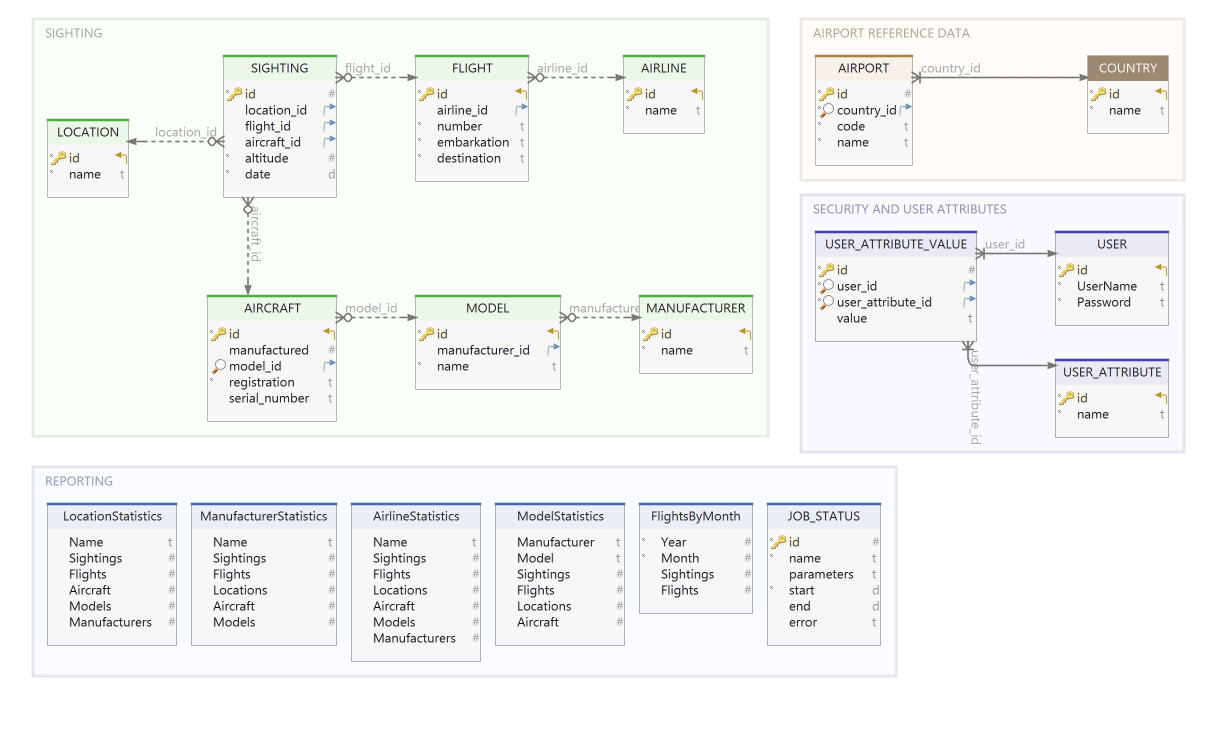-
Notifications
You must be signed in to change notification settings - Fork 0
Database

Conceptually, the schema is broken down into the following groups:
| Group | Contents |
|---|---|
| Sighting | Main data tables used for holding sighting details and related information |
| Airport Reference Data | Register of valid airport IATA codes, used for input validation |
| Ancillary | User authentication table, background job statuses and EF Core migration history |
| Keyless SQL Reports | Empty tables generated as an artifact of the SQL report configuration |
The "Sighting" group consists of the following sub-groups:
| Sub-Group | Contents |
|---|---|
| Aircraft Information | Aircraft details and associated models and manufacturers |
| Flight Information | Flight start and end points and operating airlines |
| Locations | Named locations where sightings are made |
| Sightings | Records of specific aircraft on specific flights at specific locations |
Each aircraft is associated with with a named model that, in turn, is associated with a named manufacturer. Multiple aircraft may be associated with a single model and multiple models may be associated with a single manufacturer:
| Table | Description |
|---|---|
| Manufacturer | Named manufacturer details |
| Model | Named models, each associated with a manufacturer |
| Aircraft | Aircraft registration details, each associated with a model |
Sightings are made at named locations. Multiple sightings may be associated with a single location:
| Table | Description |
|---|---|
| Location | Named location details |
Each flight has a number and route and is operated by a named airline:
| Table | Description |
|---|---|
| Flight | Flight numbers, points of embarkation and destination airports |
| Airline | Named airlines |
Each sighting is associated with a location, an aircraft and a flight and has additional details such as the aircraft altitude at the time of the sighting and the date:
| Table | Description |
|---|---|
| Sighting | The sighting records |
The registered users for the application are held in the User table. The contents of the table are used to authenticate users via the REST API.
An in-memory database is supported for unit testing. Please see the unit tests project for examples.
Prior to recording data in a SQLite database, you must ensure:
- The database file has been created
- The Entity Framework Core migrations have been run to set up the database tables required by the capture
The repository includes a database management tool that includes an option that completes the above actions for you.
To use the tool, first edit the "appsettings.json" file in the "FlightRecorder.Manager" folder and set the location where you want the database to be created:
{
"ConnectionStrings": {
"FlightRecorderDB": "Data Source=<path>/flightrecorder.db"
}
}Open a terminal window, change to your working copy of the FlightRecorder.Manager project and enter the following commands to build the project and show its "usage" message:
dotnet runThe output from the "run" command should look similar to the following:
Flight Recorder Database Management 1.5.0.0
Usage:
[1] FlightRecorder.Manager add username password
[2] FlightRecorder.Manager setpassword username password
[3] FlightRecorder.Manager delete username
[4] FlightRecorder.Manager import airports|sightings csv_file_path
[5] FlightRecorder.Manager export sightings|airports|airlines|locations|manufacturers|flights csv_file_path
[6] FlightRecorder.Manager update
[7] FlightRecorder.Manager lookup flight|airport|aircraft
Create the database in the location specified in the appsettings.json file by running the following command:
dotnet run -- updateThe output should be similar to the following:
Flight Recorder Database Management 1.5.0.0
Applied the latest database migrations
Any application that wishes to use the database should have an appsettings.json file configured as described above with the "FlightRecorderDB" connection string pointing to a copy of the database created above.